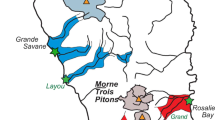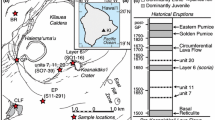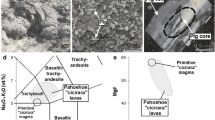Abstract
Between 1953 and 1974, approximately 0.5 km3 of andesite and dacite erupted from a new vent on the southwest flank of Trident volcano in Katmai National Park, Alaska, forming an edifice now known as Southwest (or New) Trident. Field, analytical, and experimental evidence shows that the eruption commenced soon after mixing of dacite and andesite magmas at shallow crustal levels. Four lava flows (58.3–65.5 wt% SiO2) are the dominant products of the eruption; these contain discrete andesitic enclaves (55.8–58.9 wt% SiO2) as well as micro- and macro-scale compositional banding. Tephra from the eruption spans the same compositional range as lava flows; however, andesite scoria (56–58.1 wt% SiO2) is more abundant relative to dacite tephra, and is the explosively erupted counterpart to andesite enclaves. Fe–Ti oxide pairs from andesite scoria show a limited temperature range, clustered around 1000 °C. Temperatures from grains found in dacite lavas possess a wider range; however, cores from large (>100 μm) magnetite and coexisting ilmenite give temperatures of ∼890 °C, taken to represent a pre-mixing temperature for the dacite. Water contents from dacite phenocryst melt inclusions and phase equilibria experiments on the andesite imply that the two magmas last resided at a water pressure of 90 MPa, and contained ∼3.5 wt% H2O, equivalent to 3 km depth if saturated. Unzoned pyroxene and sodic plagioclase in the dacite suggest that it likely underwent significant crystallization at this depth; highly resorbed anorthitic plagioclase from the andesite suggests that it originated at greater depths and underwent relatively rapid ascent until it reached 3 km, mixed with dacite, and erupted. Diffusion profiles in phenocrysts suggest that mixing preceded eruption of earliest lava by approximately one month. The lack of a compositional gap in the erupted rock suite indicates that thorough mixing of the andesite and dacite occurred quickly, via disaggregation of enclaves, phenocryst transfer from one magma to another, and direct mixing of compositionally distinct melt phases.
Similar content being viewed by others
Author information
Authors and Affiliations
Additional information
Received: 22 September 1999 / Accepted: 4 April 2000
Rights and permissions
About this article
Cite this article
Coombs, M., Eichelberger, J. & Rutherford, M. Magma storage and mixing conditions for the 1953–1974 eruptions of Southwest Trident volcano, Katmai National Park, Alaska. Contrib Mineral Petrol 140, 99–118 (2000). https://doi.org/10.1007/s004100000166
Published:
Issue Date:
DOI: https://doi.org/10.1007/s004100000166




